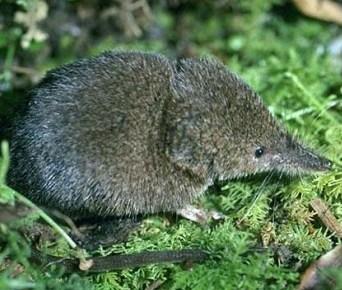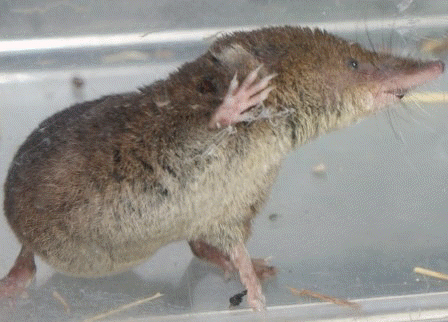|
The shrew is a small, mouse-sized mammal with an elongated snout, a dense fur of uniform color, small eyes, and five clawed toes on each foot. Shrews are similar to mice except that mice have four toes on their front feet, larger eyes, bicolored fur, and lack an elongated snout. Moles also are similar to shrews, but are usually larger and have enlarged front feet.
Both shrews and moles are insectivores, whereas mice are rodents. Food habit studies have revealed that shrews eat beetles, grasshoppers, butterfly and moth larvae, crickets, spiders, snails, earthworms, slugs, centipedes, and millipedes. Shrews also eat small birds, mice, small snakes, and even other shrews when the opportunity presents itself. Seeds, roots, and other vegetable matter are also eaten by some species of shrews.
Shrews need to consume 200-300% of their body weight each day in order to survive. A shrew must eat every two to three hours to achieve this goal. This means that a shrew may starve if it finds no food for as little as 5 hours. They do not hibernate in the winter months because their bodies are too small to hold sufficient fat reserves.
The common shrew is one of the two most widespread species of shrew in Alaska (the other being the dusky shrew). It is found from the Brooks Range to Southeast Alaska. The common shrew has a long, flexible snout, tiny ears and small eyes typical of most shrews. The fur is dark brown on the back, with paler brown flanks and a pale belly. Juveniles have lighter fur until they undergo their first molt, after which their winter coat grows. The shrew's carnivorous and insectivorous diet consists mostly of insects, slugs, spiders, small mice and worms.
The Glacier Bay Water Shrew is a species of mammal in the family Soricidae. It is endemic to Alaska..The Glacier Bay Water Shrew can swim underwater, and when it stops swimming, air trapped in its fur lets it float back up to the surface. Due to small hairs on its feet, the water shrew can actually run across the water. Its fur is water resistant, although if it does get wet it returns to shore to dry itself with its hind feet. It eats aquatic fly nymphs and terrestrial invertebrates.
The Dusky Shrew is found from Alaska, south through Canada and the western U.S. to Mexico. This shrew is rust brown dorsally and lighter below and it has a pointed nose (like all shrews). The tail is not distinctly bi-colored. It is sometimes called the montane shrew, and once was thought to be the same species as the vagrant shrew. All shrews are small; the dusky shrew is 3.7 to 4.7 inches (95 to 119 mm) in total length, its tail is 1.5 to 1.9 inches (39 to 48 mm) and it weighs only 0.25 ounce (7 grams). Accurate identification of this shrew depends on an examination of the teeth in order to differentiate it from several other shrew species.
The Pribilof Island Shrew lives in maritime tundra on St. Paul Island, and almost nothing is known about its biology. A small shrew was collected by Russian explorers in 1840. They said it came from "Unalaska," which may have meant Unalaska Island, Alaska. However, none have been found there since. A species similar to the one the Russians described (and named) was later found on St. Paul Island, one of the Pribilof Islands, now part of Alaska, and given a different name; it occurs in relative abundance there.
The St. Lawrence Island Shrew is named for the only geographic location in which it has been found, St. Lawrence Island in the Bering Sea, between Alaska and Siberia. It is the only shrew on the island, and it is common there. It has a brown back and paler sides, and is closely related to the Cinereus Shrew and the Pribilof Island Shrew. Details of the biology of the St. Lawrence Island shrew are not known.
The Tundra Shrew is common, though limited, in distribution in Alaska and extreme northwestern Canada, where it inhabits hillsides and other well-drained areas with dense vegetation. Many shrews have such uniformly grayish coats that separate species cannot easily be distinguished, but both the summer and winter coats of the Tundra Shrew are highly distinctive. Its summer pelage is tricolored, dark brown on the back, pale gray on the underparts, and brownish-gray or pale brown in between. Its longer winter fur is brown on the back and grayish on the sides and underparts.
The Barren Ground Shrew appears to prefer living in meadows of sedge-grass and thickets of dwarf willow and birch. It is similar to the Pribilof Island Shrew and the St. Lawrence Island Shrew. An inhabitant of the far north, the Barren Ground Shrew lives on the tundra from Point Barrow, Alaska, to the western shore of Hudson Bay, Canada. The fur on its back forms a well-defined brown stripe, and its sides and undersides are pale, a color pattern similar to the much larger Tundra Shrew. The tail has a small tuft on the end.
|







